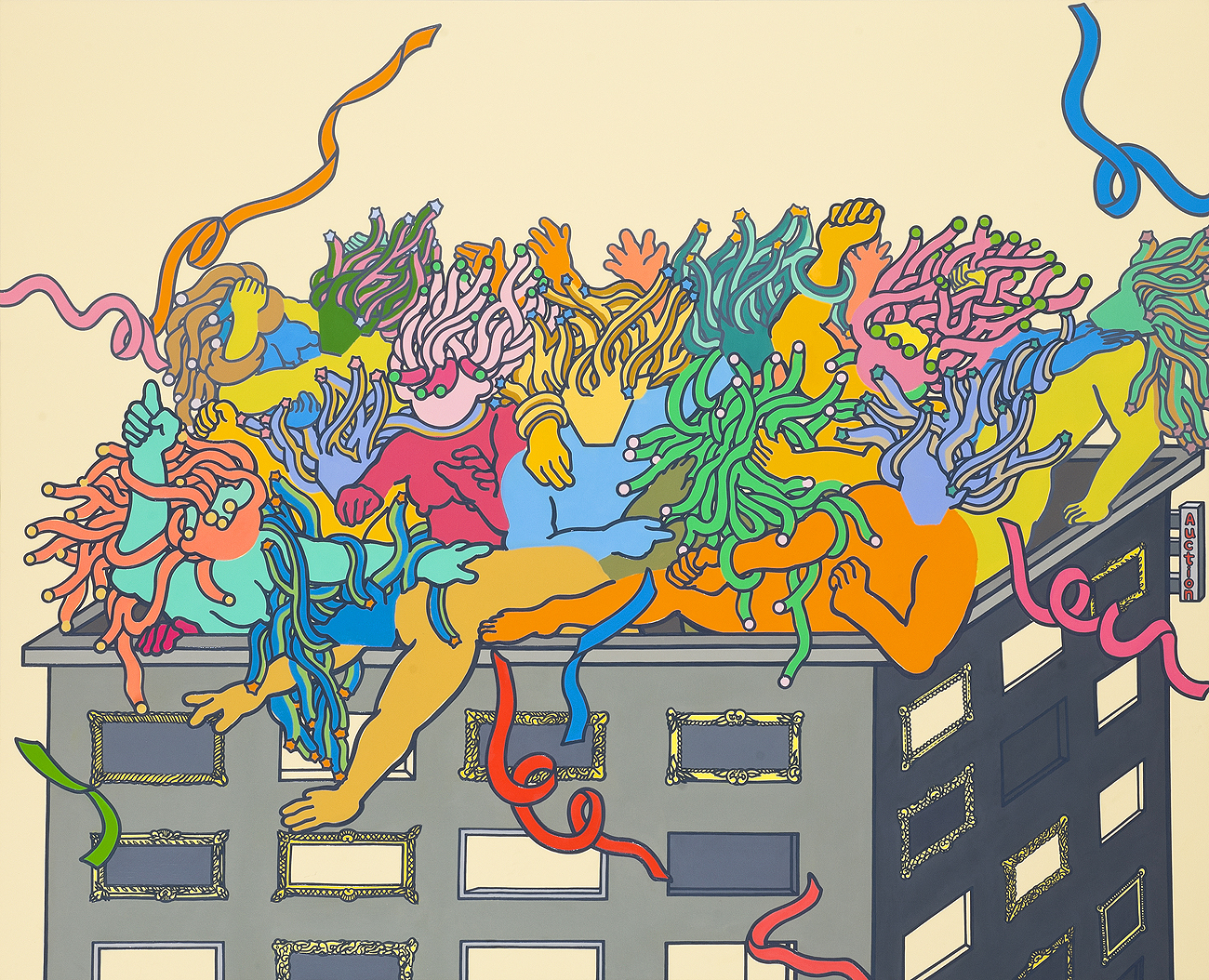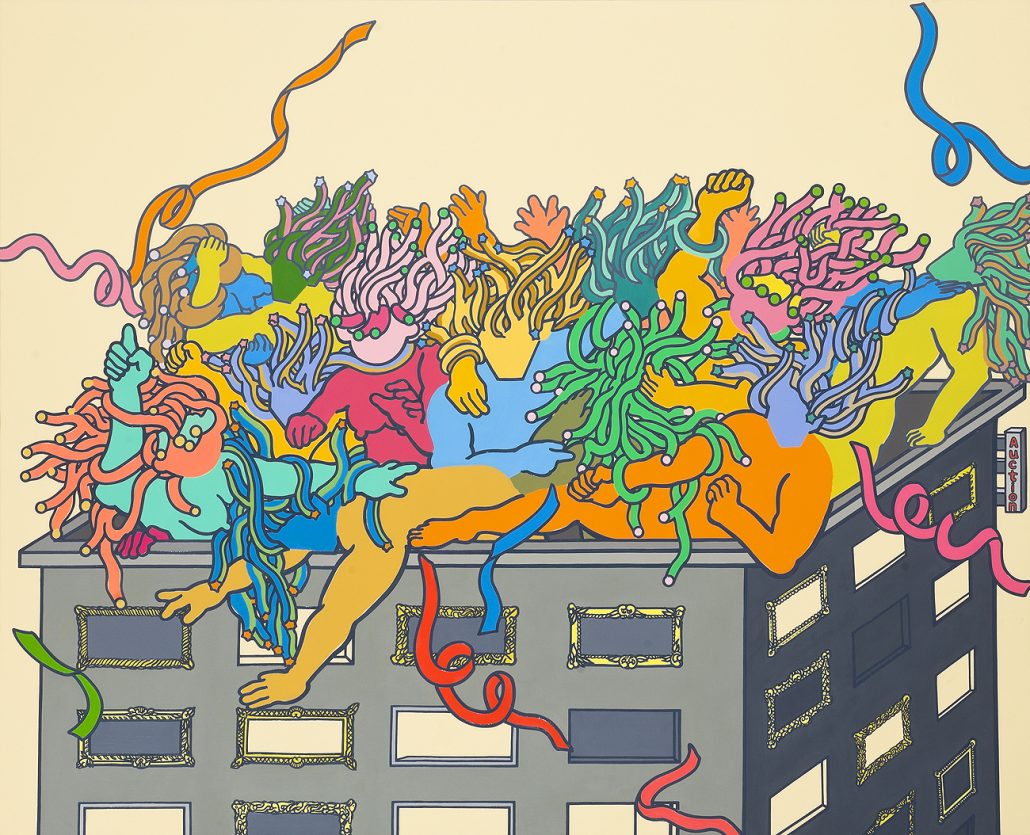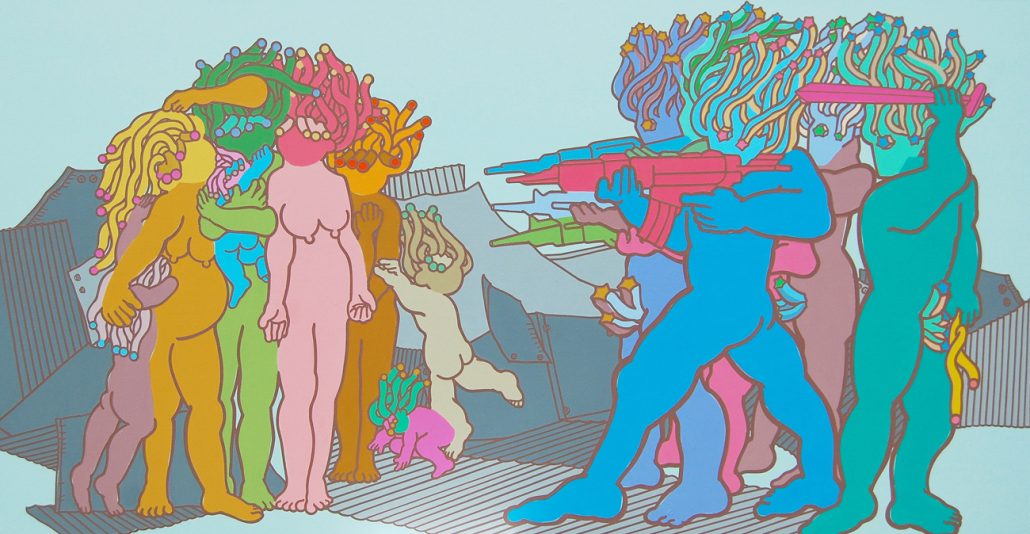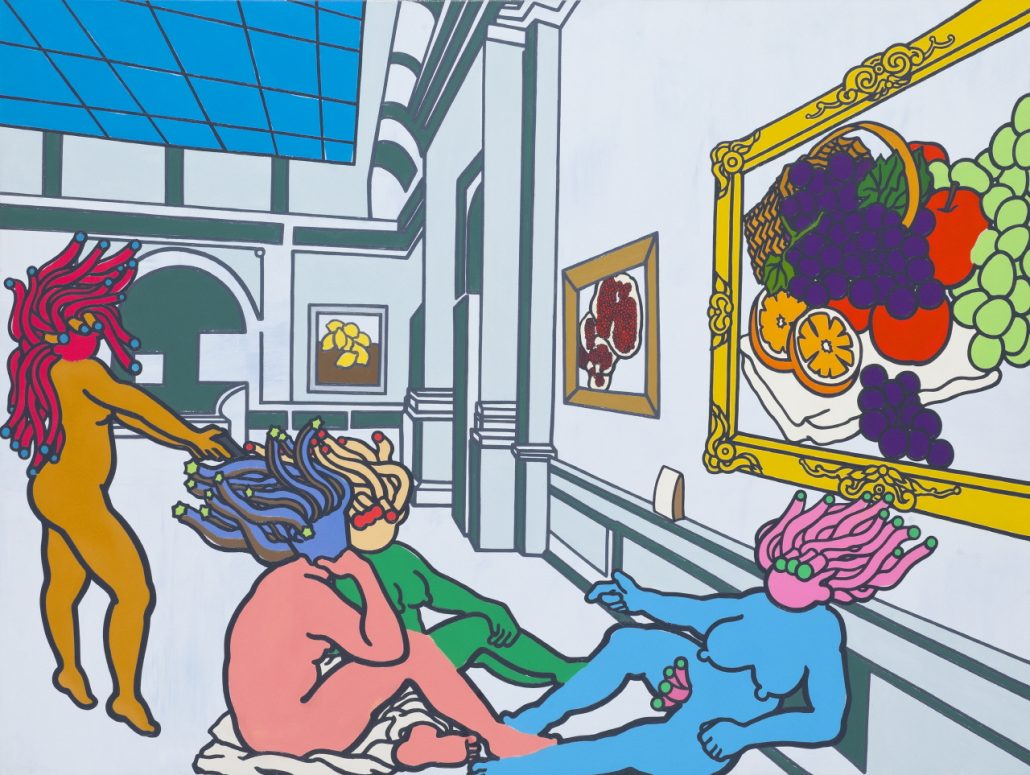
21 9월 Garden of desire – critic 2011

rooftop-party-acrylicoil-on-canvas130-3x162cm2010
Persona to expose or hide desires – Painting of Choi Na ri
Human-beings are social animals. As they can’t live by themselves, they are eager to continuously clarify their existences within systematized frame. Therefore, it’s very natural that they face various roles regardless of whether or not they want those roles. It’s very natural for them to various masks by meeting request of convention and tradition and their internal requests. A psychologist, C.G. Jung named these kinds of masks as ‘persona’ and he argued they are not only roles which society assigned to human but also roles which society wants human-beings to take charge. These masks play roles so that human-beings could get used to aspects between their own psychological structure and social requirement while the masks sometimes hide a human nature. Therefore, he who is wearing mask simply has appearance of human-beings and a human-being of entity who becomes a stranger (other person) rather than autonomous (spontaneous) human-being. Conflicts between these actual situations and psychological masks have been much appeared in subjects of cinema or art works. In art works by Choi Na Ri as well, mask-wearing characteristics to expose or hide human desires are also appearing.
Choi Na Ri has originally invented a graphical characteristic from tomato ketchup and mayonnaise ketchup. In her initial works early 2008, she performed her art works focusing on relationships between man and woman or their stories displaying characteristics named ‘Mato’ and ‘Mayo’ Her early art works have focused more on model-centric experiment and color studies highlighting characteristic aspects and dividing them into woman and man while her recent art works visualize human instinctive desires. Therefore, I’d rather think that naked characters from her recent art works an original feature of human wearing mask rather than characters. Characters at her art works usually appear with their eyes, nose and mouth erased (Although faces from a few number of her early art works are exactly recognized, most of recent art works have no eyes, nose and mouth) Even only clues to recognize gender of characters are breast or phallus associated by a penis. Naked characters of man and woman usually have pictures of waving hairs. This hair look like seaweed, sea anemone reacting by wave or tentacle of hydra and it also looks like a symbol of desire which is alive and wriggling under a world of consciousness.
The fact that the artist has chosen a tool of mask for expressing character seems to emphasize anonymity of human-beings. Her art works expressed numerous human’s desires with them alive. However, she doesn’t intend to express a specific human desire but rather intended to cover those desires with masks to express them as conventional things that everyone has. But there isn’t any facial expression in these masks while there is nothing but futility with facial expression erased.
Like this, a keyword penetrating into her overall art works is ‘desire’. Even the artist named the title of exhibition as 『Garden of desire』by herself. The artist is exposing various human’s desires as a group of naked people while she doesn’t induce any judgment from audience at all. She just directly shows a fact that human life is filled with those desires. Human sometimes wants to hide those desires or sometimes he or she don’t want to be caught against for those desires. Therefore, people might sometimes be shamed that they could be caught with their desire in front of her art works (snobbism) and also they are uncomfortable facing frank desires from her art works. For example, the artist, in her art work, 「Rooftop party」expresses people within building which is an arena toward desires of success. As described earlier, she more focused on contrast between man and woman paying more attention to aspects of characteristics at her early works while she is highlighting narrative aspects adding description of space. The artist one is representing one of cross sections of modern municipal society with people within buildings where capital is circulating . On upper area of 「Rooftop party」, are numerous people shouting tangled with each and in its background, firecracker is bursting. In addition, windows in building on lower side of it are expressed as of a photo frame in their edges and there is a small sign board labeled with “AUCTION”. In this art work of 「Rooftop party」, she is metaphorically expressing a very competitive situation she has faced in art circles while she directly shows people’s struggle toward success. However, the artist not just views the coldness and eagerness of reality by a critical aspect but she is plainly affirming by herself where she is located under those reality. This wouldn’t be just an agony which only Choi Na Ri faced and how would it be solitary, lonely and hard for a young artist in Korean society to survive under painting circles?

matomayos-massacre-acrylicoil-on-canvas100x191cm2010
An art work 「Garden of desire」describes a sexual desire. Choi Nar Ri performs parody for 「Le Déjeuner sur L’herbe」of E. Marnet which has been evaluated as a masterpiece of a milestone in modern art and she substituted the grass field of 「Le Déjeuner sur L’herbe」with an art gallery filled with many art pieces. And her naked people shoot arrows of desires into each other as if cupid shoots an arrow of love. Traditionally , fruits appeared in Western paintings symbolized a sexuality related to women.

Garden of desire, Acrylic & Oil on canvas 112 x 145.5cm 2010
Choi Na ri hanged fruits on wall of the art gallery which is charmingly shining as if she intends to visualize sexual desires of people. She seems to think that art circles are also inundating with desires as well. In addition, the artist, through her another art work 「Racing of a death」, also sends a message that the end of desire is death. Although her audience sometimes tastepleasures through never-ending race of competitiveness, in the long run, they are warned through traffic signals made of skeletons and U-turn prohibition that they eventually continue to run toward death.
S. Freud emphasized direct relations between an artist and art works in terms of the fact that the purpose for art is ultimately to fill desires for babyhood, thus which means that creative behaviors of artists are psychological masturbation and vicarious pleasure. Therefore, art creating is to express frustrated desires and there artists taste psychological a sense of freedom by filling several private desires which are suppressed. An artist, Choi Na Ri directly triggers various desires and snobbism which human possessed beyond several conflictive expressions between man and woman. People, by erupting desires which are likely to be hidden or suppressed in the art work, are looking for psychological stability. In this case, characters in an art work are disguised wearing a mask of anonymity, i.e persona as everyone might be one of them. Like this, the artist invites audience to a garden fully filled with naked desires.
KoKyongok 2011
욕망의 정원
욕망의 드러내기와 감추기를 위한 페르소나
-최나리의 회화
인간은 사회적 동물이다. 스스로 혼자 살수 없기에, 사회라는 구조화된 틀 속에서 부단히 자신의 존재를 규명하기에 여념이 없다. 이 때 원하든 원하지 않든 간에 다양한 역할에 직면하기에 이른다. 사회적 역할 앞에서 인간은 인습, 혹은 전통의 요청과 그 자신의 내적 요구에 부응해서 다양한 가면을 채택하기 마련이다. 이러한 가면을 쓴 인격에 대해 심리학자 융(C.G. Jung)은 페르소나(persona)라고 명명하며, 그것이 사회가 인간에게 부과하는 역할인 동시에, 인간에게 담당하기를 기대하는 배역이라고 말했다. 이 가면은 자신의 고유한 심리구조와 사회적 요구 사이에 적응할 수 있는 역할을 해주는데, 때때로 그 사람의 본성을 감추기도 한다. 그러니까 가면을 쓴 그는 단순히 인간의 모습을 하고 있을 뿐이며, 자발적인 인간이기보다는 사회적 역할에 충실한 타자화된 주체로서의 인간이라는 것이다. 이러한 실재모습과, 심리적 가면 사이의 갈등에 관한 내용은 영화의 주제나 미술작품에도 꾸준히 등장해 온 소재이다. 최나리의 작업에서도 인간의 여러 욕망을 드러내기와 감추기 위한 수단으로써 가면 쓴 캐릭터가 등장하고 있다.
최나리는 원래 토마토케첩과 마요네즈 튜브에서 도상화된 캐릭터를 착안하였다. 2008년의 초창기 작업에는 이러한 마토(Mato), 마요(Mayo)라는 캐릭터를 등장시키면서, 남성과 여성의 관계 혹은, 그들의 이야기에 주목하여 작품을 진행했었다. 초기의 작품이 캐릭터성을 강조하고, 여성과 남성으로 화면을 양분하여 여러 가지 조형적인 실험과 색채연구에 주안을 두었다면, 근작에는 인간 본연의 욕망을 가시화시키고 있다. 그래서 근작의 나체 인물들을 캐릭터라기 보다는 가면 쓴 인간의 원형(原形)이라고 말하고 싶다. 작품에 등장하는 인물들은 대개가 얼굴의 눈, 코, 입이 지워진 모습으로 등장한다.(초기 몇몇의 작품에서는 얼굴의 표정을 확인할 수 있으나, 근작 대부분의 작품에는 눈, 코, 입이 없다.) 그나마 나체 인물군상들의 성(性)을 알아차릴 수 있는 단서는 젖가슴이나 페니스로 연상되는 남근형상이다. 남성, 여성의 나체 인물상에는 공통적으로 흐느적거리는 머리카락이 그려져 있다. 이것은 마치 물살의 움직임에 반응하는 해초, 말미잘, 혹은 히드라의 촉수처럼 생겼는데, 의식의 세계 아래에서 살아 꿈틀거리는 욕망의 상징처럼 보이기도 한다.
작가가 인물 표현에 있어 가면이라는 도구를 선택한 것은 인간의 익명성을 강조하기 위한 것으로 보인다. 작품 안에 인간의 무수한 욕망들을 날것으로 표현하였으나, 그것을 어느 특정한 인간의 욕망이라기보다는 그 누구나가 지니고 있는 보편의 것으로 표현하기 위해 가면을 씌운 것이다. 이러한 가면에는 어떠한 표정도 찾아 볼 수 없다. 표정이 지워진 채 그저 허망한 모습이다
이처럼 최나리의 작품 전반에 걸쳐 관통하는 키워드는 ‘욕망’이다. 전시타이틀도 작가 스스로가 『Garden of desire(욕망의 정원)』이라고 지었다. 작가는 인간이 지닌 여러 욕망들을 나체의 인물군상의 모습으로 드러내면서, 관람객에게는 그 어떠한 판단도 유도하지 않는다. 그저 인간의 삶이 그러한 욕망으로 가득하다는 것을 직설적으로 보여줄 뿐이다. 이러한 욕망은 때로는 감추고 싶은 것 일수도 있고, 들키고 싶지 않은 것도 있다. 그래서 최나리의 작품 앞에서면 속물근성(snobbism)이 탄로난 것 같아 부끄럽기도 하고, 적나라하게 표현된 욕망 앞에 마음이 불편하다.
이를 테면 작가는 작품 「Rooftop party」에서는 성공을 향한 욕망의 각축장을 빌딩 안의 사람들로 묘사하고 있다. 앞서 서술한바, 기존에는 캐릭터성에 치중하여, 남성과 여성이라는 성(性)의 대비에 집중했다면, 신작에서는 공간에 대한 설명이 첨가되면서 내러티브가 강화되고 있다. 작가는 자본이 돌아가는 현대도시사회의 한 단면을 빌딩건물 안의 사람들로 대변하고 있다. 화면의 상단은 수많은 인간들이 뒤엉켜진 채 아우성을 치고 있는 모습을 표현하였고, 배경에는 폭죽이 터진 상황으로 연출하고 있다. 또한 작품 하단의 빌딩 건물의 창문은 액자모양으로 그 테두리가 묘사되고 있는데, 건물의 우측에는 “AUCTION”이라는 작은 간판이 보인다. 최나리는 성공을 향한 사람들의 몸부림을 단적으로 보여주면서, 한편으로는 자신이 처한 미술계 안의 경쟁적 상황에 빗대어 은유하고 있는 것이다. 그러나 작가는 현실의 냉혹함과 치열함을 비판적으로 바라보는 것이 아니라, 그 현실 속에서 자신의 위치가 어디쯤 인가를 스스로가 담담하게 확인하고 있다. 이것은 비단 최나리만이 안고 있는 고민은 아닐 것이다. 한국사회에서, 그것도 젊은 여성작가가 화단에서 살아남기는 얼마나 고독하고, 외롭고, 힘든 일이겠는가.
작품 「Garden of desire」에서는 성적욕망을 그려내고 있다. 최나리는 모던아트의 이정표가 되는 걸작으로 평가되는 마네(E. Marnet)의 「풀밭 위의 점심」을 패러디하고 있는데, 풀밭대신 예술품이 가득한 미술관으로 장소를 변경하였다. 그리고 미술관 안에서 나체의 사람들이 큐피드(cupid)가 사랑의 화살을 쏘듯, 서로를 향해 욕망의 화살을 쏘고 있는 모습으로 설정하고 있다. 전통적으로 서양의 회화에서 과일은 여성과 관련된 섹슈얼리티를 상징하였다. 최나리는 사람들의 성적욕망을 가시화시키려는 듯 미술관 벽에는 탐스럽게 빛나는 과일그림을 걸어놓았다. 미술관으로 대변되는 미술계 역시 욕망으로 넘쳐난다는 것이다. 또한 작품「Racing of a death」를 통해 인간이 욕망의 끝은 죽음이라는 메시지를 전달하고 있다. 끝없이 펼쳐진 경쟁의 질주를 통해 쾌락을 맛보기도 하지만, 백미러에 비치는 해골과 유턴금지의 교통표지판은 그것이 결국 죽음을 향해 달려가는 것이라고 경고하고 있는 것이다.
프로이트(S. Freud)는 예술의 목적이 궁극적으로 유아기의 소망충족이라는 관점에서 작가와 작품간의 직접적인 관련성을 중시했다. 그러니까 예술가의 창작행위가 심리적 자위이자, 대리만족행위라는 것이다. 그래서 예술창작은 좌절된 욕망을 표현하는 것이고, 이를 통해 억압된 여러 개인사적 욕망을 충족시킴으로써 예술가는 심리적 해방감을 맛보는 것이다. 최나리 작가는 여성과 남성이라는 이성간 사이의 관계 안에서 벌어지는 다양한 갈등표현을 넘어서서, 인간이 지닌 여러 욕망과 속물근성에 대해 직접적으로 발화하고 있다. 감추고 싶거나, 혹은 억압된 욕망을 작품 안에서 분출함으로써 자기만족, 혹은 치유라는 심리적 안정을 찾아가고 있는 것이다. 이때 작품의 인물들은 욕망의 소유자가 특정인이 아닌, 그 누구나가 될 수 있다는 의미에서 익명의 가면, 즉 페르소나를 쓴 채, 위장하고 있는 것이다. 작가는 이처럼 날것으로 살아난 욕망이 가득한 정원으로 관객을 초대한다.
고경옥 (이랜드문화재단 큐레이터)





